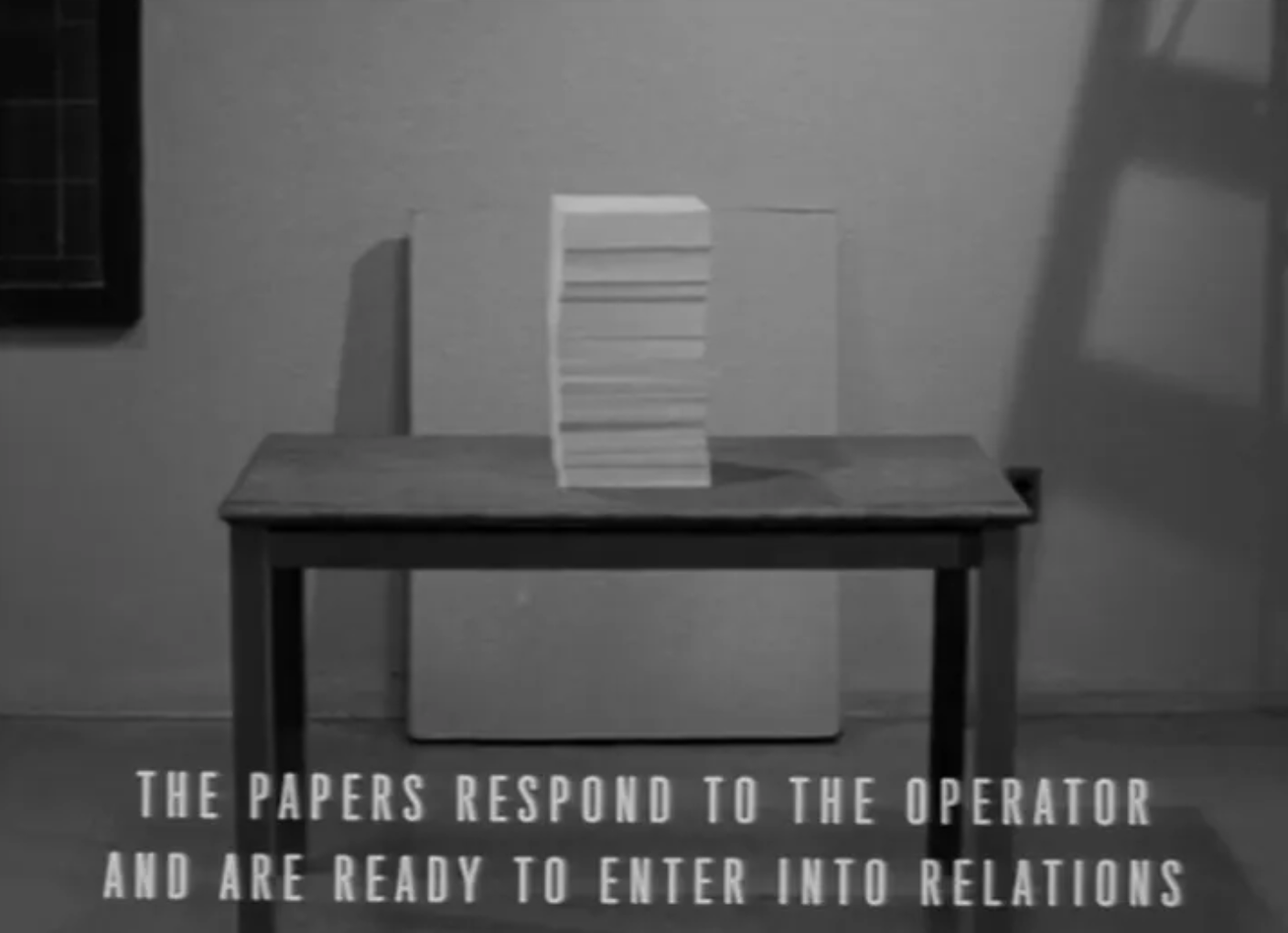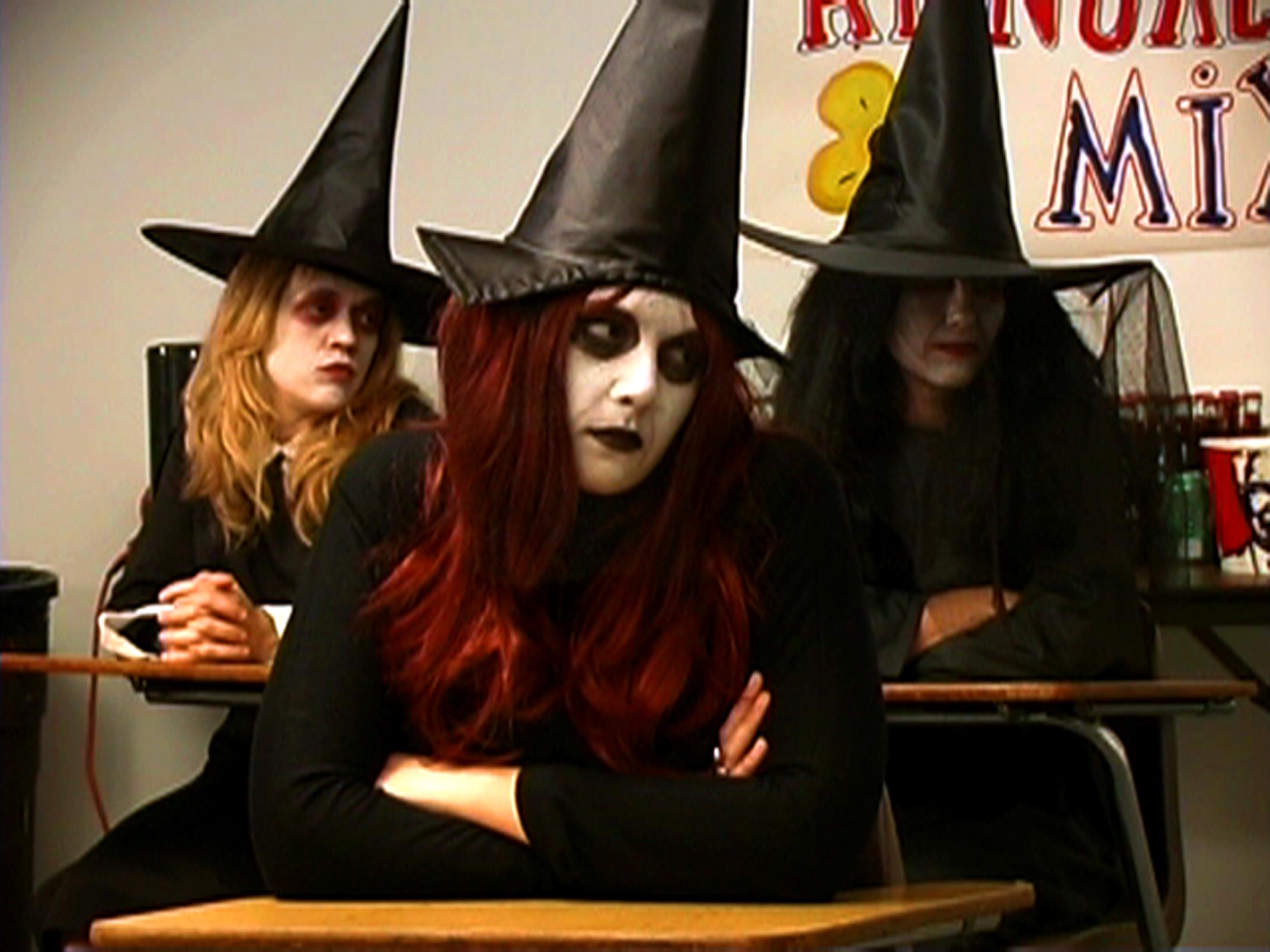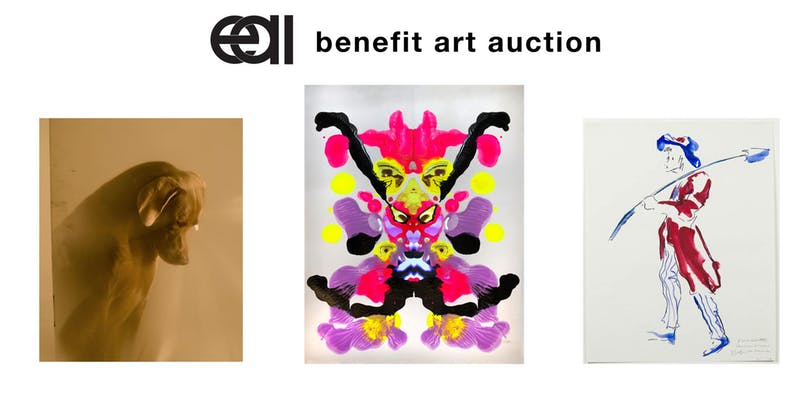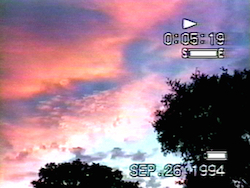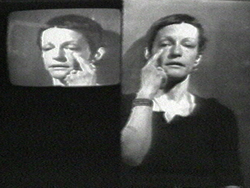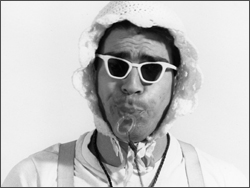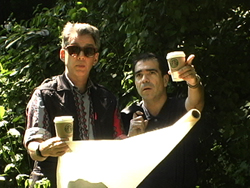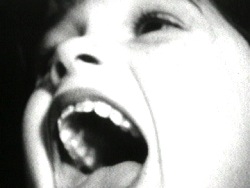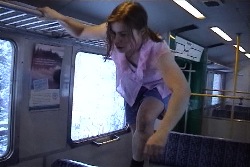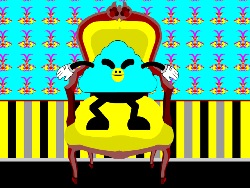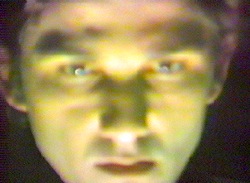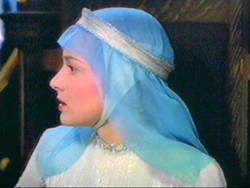Michael Smith
Related EAI Public Programs
Fundamental Motions: Recent Titles in Distribution
Electronic Arts Intermix (EAI) 264 Canal Street #3W
New York, NY 10013
December 11th, 2025
7:00 pm ET
RSVP here. Seating is first come, first serve. RSVP does not guarantee entry, but helps us track interest and send event updates and reminders.
Electronic Arts Intermix (EAI) presents a selection of works recently added to our distribution catalogue by Michael Bell-Smith and Sara Magenheimer, Zoe Beloff, Michael Smith, and Sophie Breer with David Wojnarowicz. The evening takes its title from Zoe Beloff’s The Infernal Dream (2011), which invokes Frank and Lillian Gilbreth’s time-motion studies aimed at maximizing workplace efficiency.
In this program, artists subvert systems of bodily control. Utilizing a range of ubiquitous communication formats including childrens’ television shows, Zoom calls, and industrial films, they highlight the absurdity of bureaucracy and technological optimization. Beloff’s single-channel piece—adapted from the artist’s 2011 installation, The Infernal Dream of Mutt and Jeff—reanimates two midcentury industrial films focused on maximizing productivity in the workplace through the visual language of slapstick, envisioning how metaphysically unruly objects can subvert capitalism's ideal of seamless labor protocols. Bell-Smith and Magenheimer's Acetone Reality (2025) uses computer-generated voices, animations, and found images to present a cascading meditation on the nature of meaning making. Breer’s Waje’s Cockabunnies (1981) showcases Wojnarowicz’s “cock-a-bunnies,” live cockroaches adorned with paper bunny ears and cotton tails, through the instructional format of the classic children’s television show Romper Room. Smith’s Zoom Room (2022) depicts Mike Smith, the artist’s Everyman alter-ego, as he attempts to lead a Zoom meeting with his less-than-enthusiastic staff.
An informal conversation with Beloff will follow the screening.
Electronic Arts Intermix (EAI)’s venue is located at 264 Canal Street, 3W, near several Canal Street subway stations. Our floor is accessible by elevator (63" × 60" car, 31" door) and stairway. Due to the age and other characteristics of the building, our bathrooms are not ADA-accessible, though several such bathrooms are located nearby. If you have questions about access, please contact cstrange@eai.org in advance of the event.
Electronic Arts Intermix (EAI) presents a selection of works recently added to our distribution catalogue by Michael Bell-Smith and Sara Magenheimer, Zoe Beloff, Michael Smith, and Sophie Breer with David Wojnarowicz. The evening takes its title from Zoe Beloff’s The Infernal Dream (2011), which invokes Frank and Lillian Gilbreth’s time-motion studies aimed at maximizing workplace efficiency.
In this program, artists subvert systems of bodily control. Utilizing a range of ubiquitous communication formats including childrens’ television shows, Zoom calls, and industrial films, they highlight the absurdity of bureaucracy and technological optimization. Beloff’s single-channel piece—adapted from the artist’s 2011 installation, The Infernal Dream of Mutt and Jeff—reanimates two midcentury industrial films focused on maximizing productivity in the workplace through the visual language of slapstick, envisioning how metaphysically unruly objects can subvert capitalism's ideal of seamless labor protocols. Bell-Smith and Magenheimer's Acetone Reality (2025) uses computer-generated voices, animations, and found images to present a cascading meditation on the nature of meaning making. Breer’s Waje’s Cockabunnies (1981) showcases Wojnarowicz’s “cock-a-bunnies,” live cockroaches adorned with paper bunny ears and cotton tails, through the instructional format of the classic children’s television show Romper Room. Smith’s Zoom Room (2022) depicts Mike Smith, the artist’s Everyman alter-ego, as he attempts to lead a Zoom meeting with his less-than-enthusiastic staff.
An informal conversation with Beloff will follow the screening.
Electronic Arts Intermix (EAI)’s venue is located at 264 Canal Street, 3W, near several Canal Street subway stations. Our floor is accessible by elevator (63" × 60" car, 31" door) and stairway. Due to the age and other characteristics of the building, our bathrooms are not ADA-accessible, though several such bathrooms are located nearby. If you have questions about access, please contact cstrange@eai.org in advance of the event.
Feed: Diverse Tactics in Video
Electronic Arts Intermix (EAI) 264 Canal St #3W
New York, NY, 10013
May 29th, 2025
RSVP here. Seating is first come, first serve. RSVP does not guarantee entry, but helps us track interest and send event updates and reminders.
EAI is pleased to partner with fellows from The Whitney Museum Independent Study Program (ISP) to present a screening highlighting a wide array of formal, technological, and narrative tactics in video. This event pairs a selection of recent works by nine of the program's 2024-25 Fellows alongside videos in EAI's catalogue by ISP alumni Robert Beck/Buck, Tony Cokes, and Michael Smith. Referencing the social media feed as a meeting point for wildly disparate iterations of video—from video documentation of violent atrocities, to targeted advertisements, to participatory dance videos—Feed: Diverse Tactics in Video considers the medium’s variability as material, celebrating its unique qualities and use as an artistic and political tool across decades of experimentation.
Following the screening, the evening's event organizers and current ISP Fellows Dahlia Bloomstone and Alex Schmidt will join us for a conversation and audience Q&A.
Featured ISP Fellows:
Dahlia Bloomstone
Paige K. Bradley
Joanna Evans
Daniel Melo Morales
Ash Moniz
Adrienne Oliver
Chantal Peñalosa Fong
Alex Schmidt
misra walker
Electronic Arts Intermix (EAI)’s venue is located at 264 Canal Street, 3W, near several Canal Street subway stations. Our floor is accessible by elevator (63" × 60" car, 31" door) and stairway. Due to the age and other characteristics of the building, our bathrooms are not ADA-accessible, though several such bathrooms are located nearby. If you have questions about access, please contact cstrange@eai.org in advance of the event.
EAI is pleased to partner with fellows from The Whitney Museum Independent Study Program (ISP) to present a screening highlighting a wide array of formal, technological, and narrative tactics in video. This event pairs a selection of recent works by nine of the program's 2024-25 Fellows alongside videos in EAI's catalogue by ISP alumni Robert Beck/Buck, Tony Cokes, and Michael Smith. Referencing the social media feed as a meeting point for wildly disparate iterations of video—from video documentation of violent atrocities, to targeted advertisements, to participatory dance videos—Feed: Diverse Tactics in Video considers the medium’s variability as material, celebrating its unique qualities and use as an artistic and political tool across decades of experimentation.
Following the screening, the evening's event organizers and current ISP Fellows Dahlia Bloomstone and Alex Schmidt will join us for a conversation and audience Q&A.
Featured ISP Fellows:
Dahlia Bloomstone
Paige K. Bradley
Joanna Evans
Daniel Melo Morales
Ash Moniz
Adrienne Oliver
Chantal Peñalosa Fong
Alex Schmidt
misra walker
Electronic Arts Intermix (EAI)’s venue is located at 264 Canal Street, 3W, near several Canal Street subway stations. Our floor is accessible by elevator (63" × 60" car, 31" door) and stairway. Due to the age and other characteristics of the building, our bathrooms are not ADA-accessible, though several such bathrooms are located nearby. If you have questions about access, please contact cstrange@eai.org in advance of the event.
At Home with Mike Kelley
Electronic Arts Intermix (EAI) and the Mike Kelley Foundation for the Arts www.eai.org
July 14 through September 13
Electronic Arts Intermix (EAI) and the Mike Kelley Foundation for the Arts were pleased to co-present At Home with Mike Kelley, a series of online screenings and conversations about the moving-image work of Mike Kelley. Featuring videos that span from the 1980s to 2012, this series underscores the varied and inventive art practice of Kelley, praised widely for his use of lowbrow pop cultural material and everyday arcana to interrogate the basic structures of American life. These semi-weekly online events will pair Kelley’s video work with conversations between artistic collaborators, writers, curators, admirers, and other interlocutors to parse the artist’s work and legacy.
The post-screening conversations are viewable below. Additionally, the Mike Kelley Foundation for the Arts has partnered with EAI to provide no-fee access to the full series, plus additional videos by Mike Kelley, for educational use. Learn more here or email info@eai.org for further information.
This screening series was streamed live at eai.org at selected times through July and August 2020, accompanied by live conversations and audience Q&A. Additionally, the Mike Kelley Foundation for the Arts made available Kelley’s reflections on the videos at their website mikekelleyfoundation.org, bringing forth further perspectives on and approaches to Kelley’s prolific output.
Beginning in the late 1970s with solo performances, image/text paintings, and gallery and site-specific installations, Kelley came to prominence in the following decades with a series of sculptures composed of common craft materials. Featuring repurposed thrift store toys, blankets, and worn stuffed animals, the Half a Man series focused Kelley’s career-long investigation of memory, trauma, and repression, predicated on what the artist described as a “shared culture of abuse.” Kelley’s solo and collaborative videos often tread similar territory, taking as their subject relics from the artist’s childhood, postwar Americana, and themes of social conditioning and alienation, the family, and public life.
Kelley was acutely aware of video’s attributes and possibilities, and treated his moving-image work with the same keen specificity as his performance and gallery art. Writing on his first solo videotape The Banana Man, he notes that “video and film tend to normalize fracture. The viewer is expected to jump from one image to the next and experience it as a seamless development.” For him, this quality of fracture unlocked a new dimension in his solo character-based performance, allowing for seemingly incoherent and illogical parts to settle into a contradictory yet unified whole. As a collaborator, Kelley worked in various capacities with a wide array of artists including Michael Smith, Paul McCarthy, Raymond Pettibon, Tony Oursler, Bruce and Norman Yonemoto, and Ericka Beckman. Included in this series are Beckman and Kelley’s H.G. Wells-inspired BLIND COUNTRY and his collaboration with the Yonemoto brothers, Kappa, two stunning psychodramas fusing Freudian symbology with pop imagery.
Later works by Kelley are singular in their scope and ambition. He would compare the experience of viewing his nearly three-hour opus Day Is Done, first exhibited as a sculptural installation at Gagosian Gallery in 2005, to “channel-surfing on television,” a barrage of “simultaneous and sequential scenes playing in architectural space” that recall both filmic montage and music video television. At the time of his death in 2012, Kelley had been working on an ambitious public art installation, Mobile Homestead, and had completed an accompanying feature-length travelogue documenting the journey of a full-scale replica of his childhood home across Detroit and back, in the process interviewing citizens of the artist’s hometown.
Tuesday, July 14, 2020 at 8 pm EDT (5 pm PDT):
Mike Kelley, The Banana Man, 1983
Followed by a conversation with Michael Smith, Cauleen Smith, and Ying Liu, moderated by Mary Clare Stevens and Rebecca Cleman
Tuesday, July 28, 2020 at 8 pm EDT (5 pm PDT):
Mike Kelley and Ericka Beckman, BLIND COUNTRY, 1989
Followed by a conversation with Ericka Beckman and Jamillah James
Tuesday, August 11, 2020 at 8 pm EDT (5 pm PDT):
Mike Kelley and Bruce & Norman Yonemoto, Kappa, 1986
Followed by a conversation with Bruce Yonemoto and Andrea Lissoni
August 27 to September 9, 2020:
Mike Kelley, Day Is Done, 2005–2006
Featuring a conversation between John Miller and Aura Rosenberg
September 10th to September 23rd, 2020:
Mike Kelley, Mobile Homestead, 2011
Featuring a panel featuring Carla Acevedo-Yates, architectural historian Lee Azus, artists Cary Loren and Matthew Angelo Harrison, and Laura Sillars.
The post-screening conversations are viewable below. Additionally, the Mike Kelley Foundation for the Arts has partnered with EAI to provide no-fee access to the full series, plus additional videos by Mike Kelley, for educational use. Learn more here or email info@eai.org for further information.
This screening series was streamed live at eai.org at selected times through July and August 2020, accompanied by live conversations and audience Q&A. Additionally, the Mike Kelley Foundation for the Arts made available Kelley’s reflections on the videos at their website mikekelleyfoundation.org, bringing forth further perspectives on and approaches to Kelley’s prolific output.
Beginning in the late 1970s with solo performances, image/text paintings, and gallery and site-specific installations, Kelley came to prominence in the following decades with a series of sculptures composed of common craft materials. Featuring repurposed thrift store toys, blankets, and worn stuffed animals, the Half a Man series focused Kelley’s career-long investigation of memory, trauma, and repression, predicated on what the artist described as a “shared culture of abuse.” Kelley’s solo and collaborative videos often tread similar territory, taking as their subject relics from the artist’s childhood, postwar Americana, and themes of social conditioning and alienation, the family, and public life.
Kelley was acutely aware of video’s attributes and possibilities, and treated his moving-image work with the same keen specificity as his performance and gallery art. Writing on his first solo videotape The Banana Man, he notes that “video and film tend to normalize fracture. The viewer is expected to jump from one image to the next and experience it as a seamless development.” For him, this quality of fracture unlocked a new dimension in his solo character-based performance, allowing for seemingly incoherent and illogical parts to settle into a contradictory yet unified whole. As a collaborator, Kelley worked in various capacities with a wide array of artists including Michael Smith, Paul McCarthy, Raymond Pettibon, Tony Oursler, Bruce and Norman Yonemoto, and Ericka Beckman. Included in this series are Beckman and Kelley’s H.G. Wells-inspired BLIND COUNTRY and his collaboration with the Yonemoto brothers, Kappa, two stunning psychodramas fusing Freudian symbology with pop imagery.
Later works by Kelley are singular in their scope and ambition. He would compare the experience of viewing his nearly three-hour opus Day Is Done, first exhibited as a sculptural installation at Gagosian Gallery in 2005, to “channel-surfing on television,” a barrage of “simultaneous and sequential scenes playing in architectural space” that recall both filmic montage and music video television. At the time of his death in 2012, Kelley had been working on an ambitious public art installation, Mobile Homestead, and had completed an accompanying feature-length travelogue documenting the journey of a full-scale replica of his childhood home across Detroit and back, in the process interviewing citizens of the artist’s hometown.
Tuesday, July 14, 2020 at 8 pm EDT (5 pm PDT):
Mike Kelley, The Banana Man, 1983
Followed by a conversation with Michael Smith, Cauleen Smith, and Ying Liu, moderated by Mary Clare Stevens and Rebecca Cleman
Tuesday, July 28, 2020 at 8 pm EDT (5 pm PDT):
Mike Kelley and Ericka Beckman, BLIND COUNTRY, 1989
Followed by a conversation with Ericka Beckman and Jamillah James
Tuesday, August 11, 2020 at 8 pm EDT (5 pm PDT):
Mike Kelley and Bruce & Norman Yonemoto, Kappa, 1986
Followed by a conversation with Bruce Yonemoto and Andrea Lissoni
August 27 to September 9, 2020:
Mike Kelley, Day Is Done, 2005–2006
Featuring a conversation between John Miller and Aura Rosenberg
September 10th to September 23rd, 2020:
Mike Kelley, Mobile Homestead, 2011
Featuring a panel featuring Carla Acevedo-Yates, architectural historian Lee Azus, artists Cary Loren and Matthew Angelo Harrison, and Laura Sillars.
At Home with Mike Kelley: The Banana Man
Electronic Arts Intermix (EAI) and the Mike Kelley Foundation for the Arts eai.org
July 14, 5 pm PDT / 8 pm EDT
Electronic Arts Intermix (EAI) and the Mike Kelley Foundation for the Arts are pleased to co-present At Home with Mike Kelley, a series of online screenings and conversations about the artist's moving-image work. The series launches with The Banana Man (1983), followed by a conversation with artists Michael Smith, Ying Liu, and Cauleen Smith. The event will be accessible from eai.org at 5 pm PDT / 8 pm EDT on Tuesday, July 14th. No RSVP or pre-registration is required.
View the conversation here:
Read Mike Kelley on The Banana Man on the Mike Kelley Foundation for the Arts website.
Shot in 1982 with the assistance of a performance/installation class he was instructing at the Minneapolis College of Art and Design, The Banana Man (1983) was Kelley’s first completed solo video work. Drawing upon his memories of childhood friends regaling him with their synopses of the antics of The Banana Man, a vaudeville act that appeared on Captain Kangaroo, Kelley uses his scant recollections—the Banana Man’s habit of pulling out bananas from his pocket, and his accompanying high-pitched squeal—to build out an intricate psychology of the character.
Ying Liu is a Brooklyn-based multimedia artist born and raised in a small island named Zhoushan in the East China Sea. Her evening-length, hybridized works often mix consumer technology such as VR, GoPro and GPS, and fuse mediums including theater, dance, video, and performance art with DIY props and an exuberant sense of play.
Cauleen Smith is an interdisciplinary artist, whose work reflects upon the everyday possibilities of the imagination. Operating in multiple materials and arenas, Smith roots her work firmly within the discourse of mid-twentieth-century experimental film. Drawing from structuralism, Third World Cinema, and science fiction, she makes things that deploy the tactics of these disciplines, while offering a phenomenological experience for spectators and participants.
Michael Smith is a performance, video, and installation artist who has exhibited widely at fine art and popular venues, including museums, galleries, theaters, festivals, nightclubs, children's parties, television, online, and in the street. He lives and works in Brooklyn, NY and Austin, TX.
View the conversation here:
Read Mike Kelley on The Banana Man on the Mike Kelley Foundation for the Arts website.
Shot in 1982 with the assistance of a performance/installation class he was instructing at the Minneapolis College of Art and Design, The Banana Man (1983) was Kelley’s first completed solo video work. Drawing upon his memories of childhood friends regaling him with their synopses of the antics of The Banana Man, a vaudeville act that appeared on Captain Kangaroo, Kelley uses his scant recollections—the Banana Man’s habit of pulling out bananas from his pocket, and his accompanying high-pitched squeal—to build out an intricate psychology of the character.
Ying Liu is a Brooklyn-based multimedia artist born and raised in a small island named Zhoushan in the East China Sea. Her evening-length, hybridized works often mix consumer technology such as VR, GoPro and GPS, and fuse mediums including theater, dance, video, and performance art with DIY props and an exuberant sense of play.
Cauleen Smith is an interdisciplinary artist, whose work reflects upon the everyday possibilities of the imagination. Operating in multiple materials and arenas, Smith roots her work firmly within the discourse of mid-twentieth-century experimental film. Drawing from structuralism, Third World Cinema, and science fiction, she makes things that deploy the tactics of these disciplines, while offering a phenomenological experience for spectators and participants.
Michael Smith is a performance, video, and installation artist who has exhibited widely at fine art and popular venues, including museums, galleries, theaters, festivals, nightclubs, children's parties, television, online, and in the street. He lives and works in Brooklyn, NY and Austin, TX.
EAI Benefit Art Auction
PPOW + EAI 535 West 22nd Street, 5th + 6th floor
Thursday, April 19th
EAI is pleased to announce its first-ever Benefit Art Auction, to be held on Thursday, April 19. This special event will raise essential funding towards our mission of preserving and providing access to media art’s rich legacies, while fostering powerful new voices.
silent auction hosted by P·P·O·W
535 West 22nd Street, 6th floor, New York, NY
cocktail reception & screenings at EAI
535 West 22nd Street, 5th floor, New York, NY
online bidding available on Artsy
silent auction hosted by P·P·O·W
535 West 22nd Street, 6th floor, New York, NY
cocktail reception & screenings at EAI
535 West 22nd Street, 5th floor, New York, NY
online bidding available on Artsy
"Edited at EAI": Artist to Artist
Videos by Robert Beck, Cheryl Donegan, Ursula Hodel, Nam June Paik, Seth Price, Carolee Schneemann, Trevor Shimizu, Michael Smith. Robert Buck and Cheryl Donegan in conversation.
Electronic Arts Intermix (EAI) 535 W. 22nd St. 5th Fl.
New York, NY 10011
Thursday, June 16, 2016
6:30 pm
"Edited at EAI": Artist to Artist featured the rich collaborative process and the creative relationships between artists and the artists/editors with whom they worked, through the lens of EAI's editing facility. Video works by Cheryl Donegan, Ursula Hodel, Nam June Paik, Carolee Schneemann, and Michael Smith—all edited at EAI—were shown together with works by Robert Beck, Seth Price and Trevor Shimizu, three internationally recognized artists who spent formative years as EAI editors. Featuring works from the mid-1990s to the mid-2000s, Artist to Artist was the second in EAI's "Edited at EAI" program series. Artists Robert Buck and Cheryl Donegan in conversation following the screening.
Organized in conjunction with EAI's 45th anniversary, the "Edited at EAI" series highlights a historically significant but less well-known area of EAI's programs: EAI's Editing Facility for artists, one of the first such creative workspaces for video in the United States.
Organized in conjunction with EAI's 45th anniversary, the "Edited at EAI" series highlights a historically significant but less well-known area of EAI's programs: EAI's Editing Facility for artists, one of the first such creative workspaces for video in the United States.
TerrorVision:
Spine-Tingling Signals from the EAI Vault
Electronic Arts intermix (EAI) 535 W. 22nd St. 5th Floor
New York, NY 10011
Wednesday, October 28, 2015
6:30 pm
EAI presented a seasonally themed free screening of macabre media digging through the tropes of horror cinema. Although narrative, genre, and lurid popular entertainment may seem an unlikely source of inspiration for artists' media, the grotesque—and specifically its situation within the televisual dimension—has crept into approaches as varied as the diary video, direct-camera performance, film/video hybrid, and datamosh.
By dissecting and reanimating the themes and situations of horror film and television, artists such as Peggy Ahwesh, Michael Smith, Cynthia Maughan, Cecilia Condit, Tony Oursler, and George Kuchar offer a subversive post-mortem on the syntax and politics of the genre while offering a glimpse of the unknown, mysterious, and shocking that lurk at the video signal's outer limits.
By dissecting and reanimating the themes and situations of horror film and television, artists such as Peggy Ahwesh, Michael Smith, Cynthia Maughan, Cecilia Condit, Tony Oursler, and George Kuchar offer a subversive post-mortem on the syntax and politics of the genre while offering a glimpse of the unknown, mysterious, and shocking that lurk at the video signal's outer limits.
SOUND STAGE @ EAI
Video Screening
part of
CHELSEA SOUND
A Not-For-Profit Festival of Artists in Sound
Electronic Arts Intermix (EAI) 535 West 22nd Street, 5th floor
New York, NY 10011
Saturday, October 27, 2012, 2 pm - 6pm
Sound Stage was a special Saturday afternoon screening program featuring artists' videos that are driven by music performance. Sound Stage was presented as part of Chelsea Sound: A Not-For-Profit Festival of Artists in Sound, organized jointly by Printed Matter Inc., Eyebeam Art + Technology Center, Electronic Arts Intermix and Family Business. Taking place in Chelsea's Gallery District on Saturday, October 27th, the collaboratively produced festival included a series of performances, sound installations, and video screenings throughout the day across four venues.
Featuring works from the last four decades by a diverse group of artists, Sound Stage presented a program of videos that foreground musical performance. The screening embraced artists' documentation of music performances, artists' performances that incorporate live music, and works created for the camera and screen in which musicians take center stage.
Featuring works from the last four decades by a diverse group of artists, Sound Stage presented a program of videos that foreground musical performance. The screening embraced artists' documentation of music performances, artists' performances that incorporate live music, and works created for the camera and screen in which musicians take center stage.
EAI 40th Anniversary Benefit
Electronic Arts Intermix (EAI) 535 W 22nd Street, 5th Floor
New York, NY 10011
Thursday, December 15th, 2011
7 - 10 pm
8 - 8:30pm: Performance and Video Program
EAI's 40th Anniversary Benefit included a not-to-be-missed program featuring special live performances by Joan Jonas, Shana moulton, Carolee Schneemann and Michael Smith; video pieces by artists including Charles Atles, Dara Birnbaum, Takeshi Murata, Bruce Nauman and Seth Price, among others; and music selected by Dan Graham.
SHORT SHORTS
EAI Summer Screening
EAI 535 West 22nd Street, 5th Floor
New York, NY 10011
Wednesday, August 11, 2010, 6:30 pm
EAI celebrated the art of short-form video and film with a summer screening of works that clock in at two minutes or less. Between Yoko Ono's fifteen second Eye Blink (1966) and Leslie Thornton's two minute Let Me Count the Ways: Minus 6 (2006), the forty-five works in this forty-five minute screening demonstrated why a concise statement is so powerful. Ranging from analog video abstraction to quick visual comedy, conceptual exercises to formal experiments with duration, commissioned public service announcements to critiques of the quintessential short-form structure, the TV commercial, the works in this screening demonstrated the enormous possibilities that artists have found in less than one hundred and twenty seconds.
The screening included works by Dan Asher, Beth B, Phyllis Baldino, Michael Bell-Smith, Dara Birnbaum, Cheryl Donegan, VALIE EXPORT, Forcefield, Matthew Geller, Gran Fury, Gary Hill, Ken Jacobs, Tom Kalin, Kalup Linzy, George Maciunas, Charlotte Moorman, Shana Moulton, Yoko Ono, Dennis Oppenheim, Nam June Paik, Martha Rosler, Paul Sharits, Stuart Sherman, Shelly Silver, Michael Smith, Leslie Thornton, Steina and Woody Vasulka, Lawrence Weiner and Bruce and Norman Yonemoto.
The screening included works by Dan Asher, Beth B, Phyllis Baldino, Michael Bell-Smith, Dara Birnbaum, Cheryl Donegan, VALIE EXPORT, Forcefield, Matthew Geller, Gran Fury, Gary Hill, Ken Jacobs, Tom Kalin, Kalup Linzy, George Maciunas, Charlotte Moorman, Shana Moulton, Yoko Ono, Dennis Oppenheim, Nam June Paik, Martha Rosler, Paul Sharits, Stuart Sherman, Shelly Silver, Michael Smith, Leslie Thornton, Steina and Woody Vasulka, Lawrence Weiner and Bruce and Norman Yonemoto.
45 YEARS OF PERFORMANCE VIDEO FROM EAI
P.S.1 Contemporary Art Center 22-25 Jackson Ave at the intersection of 46th Ave
Long Island City, NY 11101
November 1, 2009 - April 26, 2010
Thursday - Monday, noon - 6 pm
EAI presented 45 Years of Performance Video from EAI, a survey of four decades of artists' engagement with video and performance. This project is presented in conjunction with 100 Years, an exhibition on the history of performance art organized by P.S.1 Contemporary Art Center and Performa 09.
CHARACTER WITNESS
EAI Video Project Space X Initiative
548 West 22nd Street, Ground Floor
New York, NY 10011
Tuesday, June 23, 2009 - Friday, July 3, 2009
On June 23rd, EAI's project space will launch with Character Witness, a program of videos by artists who take on the role of actor in their own narratives. Featuring a cross-generational group of artists, including Kalup Linzy, Alex Bag, Michael Smith, MICA-TV, William Wegman, Harry Dodge and Stanya Kahn, and Nancy Holt and Robert Smithson, these works also share a focus that resonates in the current economic and cultural climate: The irreverent investigation of the artist in relation to the art world and the art market.
In casting themselves in their own stories, the artists pursue a range of strategies, from playing or voicing a suite of multiple characters to performing alongside an ensemble cast or assuming fictionalized versions of themselves. Blurring the lines between narrative, performance and documentary, the artists take on these roles to critique, question, and satirize the systems around the marketing of the artist and the selling of their art.
In casting themselves in their own stories, the artists pursue a range of strategies, from playing or voicing a suite of multiple characters to performing alongside an ensemble cast or assuming fictionalized versions of themselves. Blurring the lines between narrative, performance and documentary, the artists take on these roles to critique, question, and satirize the systems around the marketing of the artist and the selling of their art.
MICHAEL SMITH
BABY IKKI BIRTHDAY PARTY
EAI 535 West 22nd Street, Fifth Floor, New York City
Wednesday, June 18, 2008, 6:30 pm
For the first time in more than a decade, Michael Smith staged a birthday party for his legendary character, Baby Ikki, in New York City at EAI. Conceived as a mute, ambiguous character fixed neither by age nor gender, Baby Ikki is an archetype with an unclear mission, onto which spectators project their own interpretations. Guests attending the birthday party were encouraged to bring appropriate gifts for Baby Ikki.
MICHAEL SMITH + JOSHUA WHITE
Artist Talk and Screening
EAI 535 West 22nd Street, Fifth Floor, New York City
Tuesday, June 17, 2008, 6:30 pm
EAI presented a special evening with Michael Smith and Joshua White. Smith and White screened video works that they have produced together, and spoke about their long collaboration.
Over the last 11 years, Michael Smith and Joshua White have collaborated on a series of increasingly sophisticated videos and installations that incorporate Smith's deadpan and wide-eyed alter-ego, "Mike." Gullible and ever-hopeful, Smith's eponymous character is an Everyman living in a media-saturated hyper-ordinary world that he does not really understand.
Over the last 11 years, Michael Smith and Joshua White have collaborated on a series of increasingly sophisticated videos and installations that incorporate Smith's deadpan and wide-eyed alter-ego, "Mike." Gullible and ever-hopeful, Smith's eponymous character is an Everyman living in a media-saturated hyper-ordinary world that he does not really understand.
HIGH RESOLUTION: Artist's Projects at the Armory
ELECTRONIC ARTS INTERMIX VIDEO PROGRAMS
Curated by Students of The Center for Curatorial Studies
Park Avenue Armory Park Avenue at 67th Street, New York City
February 21 - 25, 2008
Electronic Arts Intermix (EAI) and The Center for Curatorial Studies at Bard College (CCS Bard) presented a series of video programs at The Park Avenue Armory during the 20th annual Art Show, organized by the Art Dealers Association of America (ADAA). EAI invited the first year graduate students in the CCS program to curate video programs out of the EAI collection. Four separate programs were produced by the students, which were exhibited on monitors in the Armory's main Hallway between February 21-25, 2008.
PERFORMANCE ON DEMAND
EAI Viewing Room at EFA Gallery
EFA Gallery 323 West 39th Street, 2nd Floor, New York City
November 2 - November 17, 2007
During the PERFORMA07 performance biennial, EFA Gallery was transformed into a video lounge to host Electronic Arts Intermix's Viewing Room, a program that provides free public access to one of the foremost collections of video art in the world. Visitors to EFA Gallery were able to choose from a curated selection of major performance-based video works by over 30 artists from the EAI Collection. Viewers were able to watch these seminal performances and contemporary classics at their own pace in a comfortable viewing environment. During the opening reception on Friday, November 2nd, programs featuring selected works were installed throughout the gallery.
INTRUDERS
NADA Art Fair
The Ice Palace 59 NW 14th Street, Miami, Florida
Friday, December 8, 2006, 6:00 pm
EAI collaborated with the NADA Art fair to present a screening of videos by artists involving intervention, intrusion, and trespassing. Documenting literal, formal, or conceptual acts of breaking and entering, their works harness disruption and surprise. Artists in the program included Bernadette Corporation, Chris Burden, VALIE EXPORT, Delia Gonzalez and Gavin Russom, Dan Graham, Klara Liden, Rachel Mason, Takeshi Murata, Michael Smith, and Ryan Trecartin.
SEEN: PAPER RAD SELECTS
WORKS FROM THE EAI COLLECTION
FACT Film, Art & Creative Technology 88 Wood Street, Liverpool, United Kingdom
September 18 & 19, 2004, 8 pm
For the Liverpool Biennial, members of artist collective Paper Rad presented a special program of video works that they selected from EAI's major collection of media art. The program included an animated introduction and conclusion created by Paper Rad specifically for this screening. Paper Rad synthesizes popular material from television, video games, and advertising, reprogramming these references with an exuberantly neo-primitivist digital aesthetic. In this program Paper Rad presented works by Forcefield, Radical Software Group (RSG), Mike Smith, Steina and Woody Vasulka, and William Wegman.
DROP CEILINGS, ACID COLORED ANYTHING
Squeaky Wheel Buffalo Media Resources, Buffalo, NY
May 9, 2003 9 pm
EAI presented a special program at Squeaky Wheel in Buffalo. Beyond the superficial connections of these videos - all made by men, all dating from the late 70s to early 80s - there is a provocative commonality in their expressionist use of video to portray an anti-hero (in most cases the artist himself), suffering an amplified cultural milieu. The program included works by Tony Oursler, Klaus vom Bruch, Ante Bozanich, Tony Labat, and Michael Smith.
RECENT AND HISTORICAL VIDEOTAPES FROM EAI
Dia Center for the Arts Video Salon and Cafe
Summer 2000
The Summer 2000 edition of this ongoing program of EAI works for the Dia rooftop Video Salon and Cafe featured works by artists including Klaus vom Bruch, Martha Rosler, Michael Smith, and Jud Yalkut.
"Edited at EAI": 45th Anniversary Series
Electronic Arts Intermix (EAI) 535 West 22nd St. 5th Fl.
New York, NY 10011
April–September, 2016
April 27: "Edited at EAI": 1972-77
June 16: "Edited at EAI": Artist to Artist
June 22: "Edited at EAI": Videos by Tom Rubnitz
July 27: "Edited at EAI": Restless Generation
Aug 16: "Edited at EAI": Video Interference
Sept 22: "Edited at EAI": Dara Birnbaum
As part of EAI's ongoing 45th anniversary celebrations, we launched a series of screenings that highlight a less well-known but historically important and creatively fertile area of our programs: EAI's Editing Facility for artists. Established in 1972 with early 1/2" open reel editing equipment, EAI's facility was one of the first such post-production workspaces for artists in the U.S. Over five decades, an extraordinary group of artists has used EAI's facility to create some of the most significant works in media art's diverse histories. Many of these artists and works will be featured in screenings throughout our 45th anniversary year.
The first screening on April 27, "Edited at EAI": 1972-77 featured an eclectic selection of works from the 1970s, charted the alternative artistic, political, and cultural expressions of artists experimenting with emergent video editing technologies and strategies. The program included early works from the 1970s by Ant Farm, Juan Downey, Jean Dupuy, Shigeko Kubota, Mary Lucier, Raindance, Anthony Ramos, Ira Schneider, and Hannah Wilke, among others.
On June 16 Artist to Artist featured the rich collaborative process and the creative relationships between artists and the artists/editors with whom they worked, through the lens of EAI's editing facility. Video works by Cheryl Donegan, Ursula Hodel, Nam June Paik, Carolee Schneemann, and Michael Smith—all edited at EAI—were shown together with works by Robert Beck, Seth Price and Trevor Shimizu, three internationally recognized artists who spent formative years as EAI editors. Artists Robert Buck and Cheryl Donegan were in conversation following the screening.
On June 22 EAI celebrated the video work of Tom Rubnitz (1956-1992), whose deliriously camp genre parodies and music videos capture the anarchic spirit and talents of the 1980s East Village scene of Club 57 and the Pyramid Club. The rich body of work that Rubnitz edited at EAI includes TV spoofs, music videos, and the musical parody Psykho III The Musical (1985). Artist John Kelly participated in a conversation following the screening.
On July 27 Restless Generation focused on a group of conceptually driven performance videos by women artists who reenergized and redefined the genre in the 1990s, as seen through the lens of EAI's editing facility. These lo-fi performances staged for the camera—by artists such as Vanessa Beecroft, Alix Lambert, Kirsten Mosher, Alix Pearlstein, and Beverly Semmes, among others—evoke the strategies of the first generation of artists working with video in the early 1970s, even as their bold stylizations, ironic sensibility, and explicit nods to consumer culture announced a fresh approach to representations of female identity and the body that spoke emphatically to its time.
On August 16 the series continued with an evening of activist video work from the late 1980s through the mid-1990s. Shot largely on low-end consumer equipment and edited, often off-hours, at EAI, these works use video as an activist tool, confronting urgent issues around the AIDS crisis, race, gender, and sexuality. Videos by ACT UP affinity groups DIVA TV (Damned Interfering Video Activist Television) and House of Color, as well as art collective X-PRZ, were screened along with work by artists Robert Beck and Tom Kalin.
June 16: "Edited at EAI": Artist to Artist
June 22: "Edited at EAI": Videos by Tom Rubnitz
July 27: "Edited at EAI": Restless Generation
Aug 16: "Edited at EAI": Video Interference
Sept 22: "Edited at EAI": Dara Birnbaum
As part of EAI's ongoing 45th anniversary celebrations, we launched a series of screenings that highlight a less well-known but historically important and creatively fertile area of our programs: EAI's Editing Facility for artists. Established in 1972 with early 1/2" open reel editing equipment, EAI's facility was one of the first such post-production workspaces for artists in the U.S. Over five decades, an extraordinary group of artists has used EAI's facility to create some of the most significant works in media art's diverse histories. Many of these artists and works will be featured in screenings throughout our 45th anniversary year.
The first screening on April 27, "Edited at EAI": 1972-77 featured an eclectic selection of works from the 1970s, charted the alternative artistic, political, and cultural expressions of artists experimenting with emergent video editing technologies and strategies. The program included early works from the 1970s by Ant Farm, Juan Downey, Jean Dupuy, Shigeko Kubota, Mary Lucier, Raindance, Anthony Ramos, Ira Schneider, and Hannah Wilke, among others.
On June 16 Artist to Artist featured the rich collaborative process and the creative relationships between artists and the artists/editors with whom they worked, through the lens of EAI's editing facility. Video works by Cheryl Donegan, Ursula Hodel, Nam June Paik, Carolee Schneemann, and Michael Smith—all edited at EAI—were shown together with works by Robert Beck, Seth Price and Trevor Shimizu, three internationally recognized artists who spent formative years as EAI editors. Artists Robert Buck and Cheryl Donegan were in conversation following the screening.
On June 22 EAI celebrated the video work of Tom Rubnitz (1956-1992), whose deliriously camp genre parodies and music videos capture the anarchic spirit and talents of the 1980s East Village scene of Club 57 and the Pyramid Club. The rich body of work that Rubnitz edited at EAI includes TV spoofs, music videos, and the musical parody Psykho III The Musical (1985). Artist John Kelly participated in a conversation following the screening.
On July 27 Restless Generation focused on a group of conceptually driven performance videos by women artists who reenergized and redefined the genre in the 1990s, as seen through the lens of EAI's editing facility. These lo-fi performances staged for the camera—by artists such as Vanessa Beecroft, Alix Lambert, Kirsten Mosher, Alix Pearlstein, and Beverly Semmes, among others—evoke the strategies of the first generation of artists working with video in the early 1970s, even as their bold stylizations, ironic sensibility, and explicit nods to consumer culture announced a fresh approach to representations of female identity and the body that spoke emphatically to its time.
On August 16 the series continued with an evening of activist video work from the late 1980s through the mid-1990s. Shot largely on low-end consumer equipment and edited, often off-hours, at EAI, these works use video as an activist tool, confronting urgent issues around the AIDS crisis, race, gender, and sexuality. Videos by ACT UP affinity groups DIVA TV (Damned Interfering Video Activist Television) and House of Color, as well as art collective X-PRZ, were screened along with work by artists Robert Beck and Tom Kalin.

